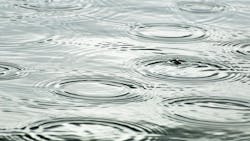Flashy raw water is difficult to define, however, it is commonly used in the industry.
The term can be used in the context of drinking water and raw water wastewater in relation to wet weather events.
The difference between flashy raw water and raw water encompasses the extremity and duration of the weather conditions.
“How extreme is the event and how long or short does it last, defines the flashiness,” states Jim Georger, Western Regional Sales Manager for Veolia Water Technologies in an interview with Bob Crossen, WWD Senior Managing Editor. “Non-flashy water would be something that is normal, something that the plant sees year in and year out. They’ve seen it before and it’s somewhat predictable, that’s the norm. Flashy to me is the unknown, the unpredictable, the differences that people are seeing and then what we do about it.”
According to The Kansas River Authority, a flashy stream generally experiences a “rapid increase in flow shortly after onset of a precipitation event, and an equally rapid return to base conditions shortly after the end of the precipitation event.”
What Conditions Make Raw Water Flashy?
Climate change has impacted the normal quality of water. For the most part, raw weather is affected by weather patterns, according to Georger. Components of flashy water include algae blooms, pesticides, and particulates in solids. Mountain runoff, early season warming, and rain events add to the turbidity of the raw water.
Impervious surfaces and agricultural land can also lead to an increase in flashiness.
The turbidity of water is measured in Nephelometric Turbidity Units (NTU).
“Now we’re seeing numbers about 50 in the range of simply 100 to 200, and in some cases like in Boulder, Colorado, 1200 NTU, so there’s been real extremes,” according to Georger.
According to the EPA, “flow is flashier with higher peak flows, shorter duration flow events, and more frequent high flows.
Example of Flashy Raw Water
The Mad River, located in Ohio, is known as a “flashy” river, as its combination of elements (steep terrain, thin soils and intense storms) causes the river to rise quickly.
The Yangtze River’s raw water has medium turbidity and low dissolved organic matters.
An example of flashy raw water as it relates to drinking water is in Boulder, Colorado, according to Georger. The filters got so overloaded in this area that the water had nowhere to go, taking a plant offline.
“Most drinking water plants are well designed,” Georger says. “They have tolerances, they can adjust when the raw water quality changes. As far as duration goes…if a plant has to adjust and do as much as it can the longer it operates, the more the solids start backing up into the system. The sludge in the settling tanks, the solids slow down the filters. Once these things get overloaded, the plant has to shut down.”
Mitigating Flashy Raw Water
Flashy raw water is a costly issue for plants. If utilities are not meeting their permits, this could lead to fines.
There are a few cost-effective routes when it comes to plants to mitigate the issue. Size of the plant and the operations must be considered in this case, as membranes and RO may be too costly for the weather events that occur only a few times a year, Georger notes.
Some newer technologies include Veolia’s Actiflo, which is a conventional treatment option that can treat the flashy raw water while managing its unpredictable high flows. According to Georger, this technology can look at different chemicals, mixing intensities and more if the flashy water brings in any new or different contaminants.
The Kansas River Authority adds that “flashiness in a stream can be increased or decreased by a variety of land use/land cover changes in the stream's watershed.”
Some other mitigation strategies to decrease flashiness include restoring native vegetation and implementing rain gardens, grass swales, and forested riparian buffers.
